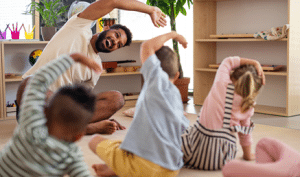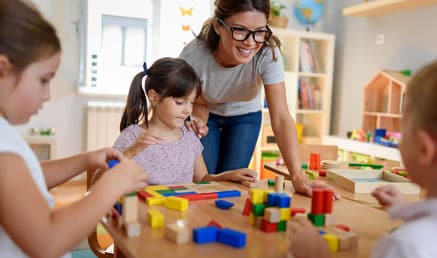
“It’s our polite nudge in the ribs to help you and your team stay organised and on task.”
This week’s subject is: Intentional Teaching.
Element 1.2.1: Educators are deliberate, purposeful, and thoughtful in their decisions and actions.
How do educators reflect on the impact and effectiveness of their intentional decisions in shaping the learning and development of children and young people? How is this documented?
As we know, in ECEC settings every interaction, routine, and experience provides opportunities for educators to foster children’s development and scaffold learning. But how do educators ensure that these opportunities are more than just spontaneous experiences and ensure they ustilise teachable moments to extend children’s leaning? The answer lies in intentional teaching, an approach that requires educators to be purposeful and deliberate in their practices, facilitating rich learning environments that meet the diverse and evolving needs of children.
Intentional teaching requires educators use their professional knowledge to plan learning experiences, environments and routines that are based on children’s knowledge, interests, strengths, and needs. It involves educators planning and engaging with children in ways that promote deep, meaningful learning experiences, where educators are proactive in their approach, reflecting on children’s interests, and drawing on their professional knowledge to design experiences that stimulate curiosity, encourage problem-solving, and foster emotional and social growth.
Educators who embrace intentional teaching are engaged in ongoing critical reflection, both individually and collaboratively, asking themselves questions like; “What do I want the children to learn from this activity?” “How can I support children’s agency whilst learning through the physical environment?” “What strategies will best support children to make connections and build new knowledge?”.
Intentional teaching empowers educators to move beyond simply facilitating play and instead become active participants in guiding children’s learning. Intentional educators adopt a range of practices to create rich, responsive learning environments and experiences that foster children’s development and a lifelong love of learning. Critically reflect with your team, considering what intentional teaching strategies are currently being implemented and how educators can improve their practice, both individually and collectively. Do educators:
-
- continually provide opportunities for children to engage in problem-solving during play, to challenge and extend their thinking and knowledge?
- facilitate collaborative learning experiences that encourage peer interaction and teamwork?
- use routines such as mealtimes, applying sunscreen or handwashing as opportunities to scaffold children’s contextual knowledge recognising these as “teachable moments” to implement intentional teaching strategies to extend children’s learning?
- use transitions between activities and routines as opportunities for meaningful interactions and learning?
- position resources and organise the physical environment in ways that support children’s learning and development, allowing them to explore, be challenged and extend their skills and thinking?
- recognise that learning occurs in social contexts and that interactions and communication are vitally important for learning?
- reflect on their teaching practices to assess whether they meet the diverse needs of all children?
- encourage children to take calculated risks in their play and learning, while providing a safe and supportive environment?
- regularly communicate with families to ensure continuity of learning between home and the education setting?
- incorporate cultural and family experiences and perspectives into the planning of learning environments and the educational program?
- ensure they’re fully present and listen to children intently throughout their play and are mindful of opportunities to provide children the time and space to “be”?
- recognise when to step back to allow children to lead their learning?
- use a variety of purposeful strategies including role modelling, demonstrating, inquiry, open ended questioning, speculating, explaining and engaging in sustained shared conversations to scaffold children’s thinking and learning?
- provide time and learning experiences that facilitate thoughtful and challenging conversations with children?
- use their professional expertise and knowledge of individual children to plan programs that scaffold and extend each child’s learning and development?
- move flexibly in and out of different roles and draw on different strategies as the context of children’s play changes and evolves?
- support children to recognise when play is unfair and work with children to build a caring, equitable and inclusive learning community?
- plan and spontaneously implement strategies to promote learning and extend knowledge across all aspects of the program and service delivery?
- consider children with diverse inclusion needs and make reasonable adjustments to support their meaningful participation and engagement in the program ( Early Years Learning Framework; and the Framework for School Age Care)?
- facilitate the integration of popular culture, media and digital technologies, which add to children’s multimodal play and learning experiences?
- encourage children to reflect on their learning and articulate their thoughts, ideas, and discoveries?
- evaluate the effectiveness of their teaching strategies and adjust as needed to support children’s development?
Resources:
EYLF- Play-based Learning and Intentionality
MTOP- Play, Leisure and Intentionality
We Hear You- Intentionality Through the Physical Environment
Being Playful with Multimodal Literacies
The Spoke- Finding the Balance: Play-based Learning and Intentional Teaching, Intentional Teaching Leads to Purposeful Play-based Learning
The Environment as the “Third Teacher”
Within System7 go to Quality Area 1/ Module 4 to submit self-assessment notes and if required, open a QIP issue if you identify any areas of improvement.
The Childcare Centre Desktop has a range of resources to assist services with physical environment. These include risk assessment and safety check templates and much more.
Resources, NQS Element, Regulation and System7 links:
Childcare Centre Desktop – Childcare Centre Desktop
National Quality Standard – QA 1- 1.2.1- Intentional Teaching
National Regulations – 73, 74, 155, 156
System7 Module – QA 1/ Module 4
If you have any questions, send us a note via the Contact page here!




